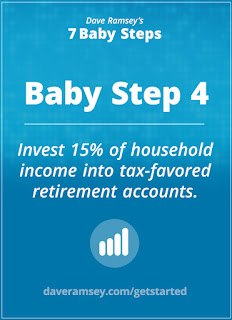Baby Step 4 - Investing
Let’s talk investing. The last four steps can be done simultaneously, but I am going to address them separately. Baby Step 4 involves investing. You should invest 15% of your gross household income into Roth IRAs and tax-favored retirement plans.
Why 15%? You can work on the last 4 of the baby steps simultaneously: pay off your mortgage, save for college for your kids, etc. while investing at the same time. 15% is a safe rate to invest. Once you have paid off your home and your kid’s college fund is fully funded you can always increase the amount that you are investing.
One thing you should check on is whether your company offers a Roth 401(k) option. Companies sometimes offer matching funds for your 401(k). What this means is that for every dollar that you put into your Roth 401(k) your company may match that amount. This is free money. If you are on this step, you should be maxing your 401(k) option. Invest your entire 15% here. The best part about this is that the dollars in your 401(k) have already been taxed so they grow tax free. You can also have this set up to automatically withdraw from your account, so you never miss it. Also, check to ensure that the plan offers plenty of good mutual fund options so you can make the best of your investments. Spreading your investments across many companies helps you avoid risks that come with investing in single stocks.
So, let’s say your company doesn’t offer matching for investment up to 15%? They only match up to 3%. What do you do? Simple. Invest 3% into their program (max out) and invest the rest of your money (12%) into a Roth IRA. Keep in mind when investing in the Roth IRA that you have maximum contribution amounts. It’s $5,500 for those 50 and under and $6,500 for 50 and older. Save the rest in your 401(k).
Here’s an example for you:
Gross income: $50,000
Amount to invest (15%): $7,500
401(k) contribution of 3%: $1,500
Amount remaining to invest: $6,000
Roth IRA investment: $5,500
Amount remaining to invest: $500
Additional 401(k)contribution: $500
Amount remaining: $0
If you’re at this step you should get with a professional, a financial advisor, to help you manage your money.
Advantages of a 401(k)
-contribution limit. You can invest $19,500 a year in
401(k), 403(b) not including the employer match. If you’re 50 or older, you can
add an additional $6,500 per year (($26,000). This is why if your employer
offers an employer match, you should take advantage of it. There is also a tax
break. When you invest in your 401(k)
with pretax dollars, you lower your taxable income for that year.
Disadvantages of 401(k)
-you have fewer options for mutual funds. Your employer
hires a third-party administrator to run the company’s retirement plan.







Comments
Post a Comment